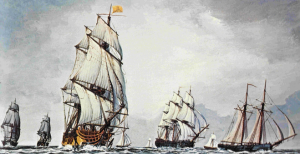Those who go down to the sea in ships have their own language.
Here is the dictionary section containing “C” words (get it “sea” words = “C” words? Never mind).
I bet you thought you knew what a “Cable” was. Not so fast. Sailors can convolute the meaning of any word. Just watch. . .
CABLE is a unit of measure, but it is based on the actual length of a cable, which was the very thick hemp line (the landlubber word for “line” is rope) that ran between the sailing ship and the anchor. This line was 1/10th of a nautical mile long. Hence the unit of length termed “cable” is 1/10th of a nautical mile, or 200 yards
Let me give you a “Clew” about what the next word is. You guessed it!
As a noun, CLEWS are the lower corners of a square sail or the aft corner of a triangular sail. As a verb, such as ‘CLEW UP’, it means to draw the clews up to the yard arm. This makes the sails ineffective for sailing but gets them out of the way quickly if the ship is going into battle. That is very important with all the burning powder and flying, flaming, felt wads in the air.
Lets see how “Close” you can come to defining the last word.
Sailing CLOSE to the wind means to sail into the wind. The more directly a ship sails into the wind, the closer it is to the wind.

Those are the “C” words in my nautical dictionary. Drop me a line if you have a question about a particular sailor word (keep it clean.).
